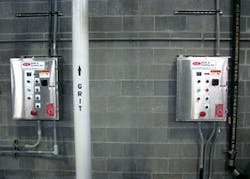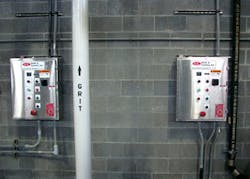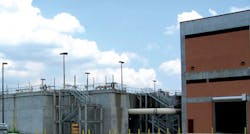Large Plant Overhaul Features Superior Hydraulic Grit Removal Efficiency
Home to the state capital, two major universities, several Fortune 1000 companies, and a rich cultural heritage, the city of Baton Rouge is one of America's most dynamic, growing cities. Its nickname "Red Stick" dates back to 1699 when Europeans began settling there and establishing military strongholds as early as 1719. Today, and seven national flags later, the city serves as the seat of Louisiana's most populated parish, East Baton Rouge (population 440,171), and the center of a burgeoning metropolitan area of more than 800,000.
Historically, the unified City-Parish Department of Public Works has operated three different wastewater treatment plants -- North, Central, and South. Since 2008, the city-parish has undertaken monumental capital improvements to expand its wastewater collection and treatment infrastructure. Plans called for the eventual decommission of the Central Plant and diversion of its flows to an expanded and upgraded South Plant (SWWTP). The city-parish estimates that more than $36 million per year will be saved in capital and operational costs with Central's closure and consolidation.
In order to handle the increased capacity of 205 million gallons per day (MGD), several segments of the SWWTP required significant overhaul and expansion to be accomplished in three major improvement projects. Phase 1, designed by CDM Smith, went partially online in March 2013 and features a more efficient screening and grit removal system with larger capacity. The entire facility is divided into six 41-MGD trains, including six PISTA® 360™ Grit Chambers, each equipped with internal flow velocity baffles.
Grit removal is a necessary investment for the plant in order to protect the downstream equipment from abrasion. With the plant's history of sanitary sewer overflows and build-up in its primary settling tanks from poor-performing headworks, reliable performance over a range of daily flows was essential. Project specifications called for removal efficiencies of 95 percent. Given their experience with large flow systems, the project designers turned to Smith & Loveless. With more than 2,500 grit removal system installations, including hundreds with individual capacities of 50 MGD and greater, Smith & Loveless offered the right expertise and equipment for the project.
PISTA technology offered specific benefits to fit the needs of the project. High removal efficiencies originate from the PISTA 360 Grit Chamber's hydraulic design, including its flat chamber floor, internal baffling and low-energy axial-flow propeller. The system's patented V-FORCE BAFFLE™ is an integral flow control device for both the inlet and outlet of the chamber. It directs the inlet flow into the chamber, ensuring the proper vortex flow. This sweeps the grit along the flat floor toward the center opening of the lower grit storage hopper. The baffle allows for a full 360-degree flow rotation and provides maximum travel for the most effective grit removal.
In the outlet, the V-FORCE BAFFLE™ directs the flow out of the unit and acts as a "slice weir" to control the water level in the main chamber and in the inlet channel. No additional downstream flow control device is required to keep the velocity between 3.5 fps at peak flow and 1.6 fps at minimum flow with a 10:1 turndown. By increasing chamber velocity during low-flow periods, the baffle extends the grit extraction path within the vortexing grit chamber.
The new preliminary treatment system has been online for more than a year with partial flows. In July 2014, initial grit testing was undertaken to evaluate the incoming grit into the plant as well as the removal efficiency performance of the new grit removal system. The average daily flow was 23.8 MGD. The cumulative results demonstrated excellent removal efficiency of 97.9 percent down to 105 micron/140 mesh particle size.
More WaterWorld Current Issue Articles
More WaterWorld Archives Issue Articles


